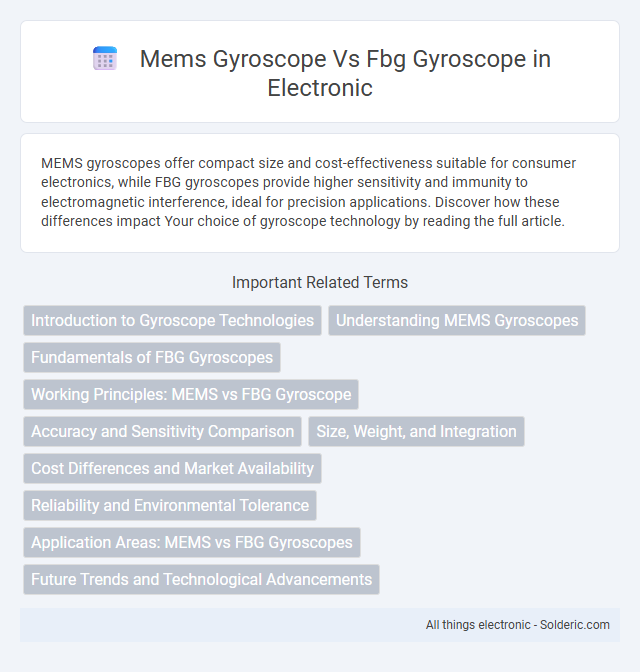MEMS gyroscopes offer compact size and cost-effectiveness suitable for consumer electronics, while FBG gyroscopes provide higher sensitivity and immunity to electromagnetic interference, ideal for precision applications. Discover how these differences impact Your choice of gyroscope technology by reading the full article.
Comparison Table
| Feature | MEMS Gyroscope | FBG Gyroscope |
|---|---|---|
| Technology | Micro-Electro-Mechanical Systems | Fiber Bragg Grating optical sensing |
| Sensitivity | Moderate sensitivity | High sensitivity |
| Size | Compact, small footprint | Relatively larger due to optical components |
| Cost | Low cost, mass-produced | Higher cost, specialized manufacturing |
| Robustness | Good mechanical robustness | Highly resistant to EMI and corrosion |
| Accuracy | Good for general applications | Superior accuracy and stability |
| Application | Consumer electronics, automotive, drones | Industrial, aerospace, high-precision navigation |
| Power Consumption | Low power consumption | Higher power due to optical components |
Introduction to Gyroscope Technologies
MEMS gyroscopes utilize microelectromechanical systems to detect angular velocity through vibrating structures, offering compact size and low power consumption ideal for consumer electronics and automotive applications. Fiber Bragg Grating (FBG) gyroscopes employ optical fibers with Bragg gratings that sense rotational changes by measuring wavelength shifts in reflected light, providing high sensitivity and immunity to electromagnetic interference crucial for aerospace and structural health monitoring. Both technologies enable precise angular rate measurements but differ fundamentally in operational principles, integration complexity, and target industry applications.
Understanding MEMS Gyroscopes
MEMS gyroscopes utilize microelectromechanical systems technology to detect angular velocity through vibrating structures, offering compact size, low cost, and high reliability ideal for consumer electronics and automotive applications. Unlike MEMS, FBG gyroscopes employ fiber Bragg gratings to measure angular rate by detecting strain changes in optical fibers, providing superior sensitivity and resistance to electromagnetic interference but at a higher cost and complexity. Understanding the trade-offs between MEMS and FBG gyroscopes helps you select the appropriate sensor technology based on application requirements for precision, size, and environmental conditions.
Fundamentals of FBG Gyroscopes
Fiber Bragg Grating (FBG) gyroscopes rely on the modulation of light within an optical fiber, where periodic variations in the fiber's refractive index reflect specific wavelengths. This fundamental principle allows FBG gyroscopes to measure angular velocity by detecting shifts in reflected light caused by mechanical strain or rotation. Your choice between MEMS and FBG gyroscopes should consider that FBG devices offer high sensitivity and immunity to electromagnetic interference, making them ideal for precision applications in challenging environments.
Working Principles: MEMS vs FBG Gyroscope
MEMS gyroscopes operate based on the Coriolis effect, where a vibrating mass detects angular velocity through changes in oscillation caused by rotation. In contrast, FBG (Fiber Bragg Grating) gyroscopes use optical interference patterns within fiber gratings to measure phase shifts induced by rotational movements. The difference in sensing mechanisms results in MEMS gyroscopes being compact and suitable for low-cost applications, while FBG gyroscopes offer higher sensitivity and immunity to electromagnetic interference.
Accuracy and Sensitivity Comparison
MEMS gyroscopes offer moderate accuracy and sensitivity suitable for consumer electronics and automotive applications, with typical bias instability around 0.01deg/s and noise density near 0.01deg/Hz. FBG gyroscopes exhibit superior accuracy and sensitivity, benefiting from fiber optic technology that achieves bias instabilities as low as 0.0001deg/s and higher resolution due to minimal environmental interference. Your choice between these gyroscopes depends on the precision required, with FBG gyroscopes preferred for high-end navigation systems demanding exceptional accuracy.
Size, Weight, and Integration
MEMS gyroscopes are compact, lightweight devices ranging from a few cubic millimeters to a few cubic centimeters, enabling easy integration into consumer electronics and mobile platforms. FBG gyroscopes, relying on fiber optic technology, are generally larger and heavier due to fiber coils and optical components, making them more suitable for industrial and aerospace applications. MEMS offer seamless integration with microelectronic systems, while FBG gyroscopes require specialized optical interfaces, resulting in more complex system integration but higher sensitivity and stability.
Cost Differences and Market Availability
MEMS gyroscopes offer significantly lower manufacturing costs due to their use of established semiconductor fabrication processes, making them widely accessible in consumer electronics and automotive markets. FBG gyroscopes, leveraging fiber Bragg grating technology, involve complex photonic components and precise optical interrogation systems, resulting in higher production expenses and limited availability primarily in specialized industrial and aerospace applications. Market demand favors MEMS gyroscopes for mass-market affordability and integration, while FBG gyroscopes serve niche sectors requiring superior sensitivity and environmental resilience despite their premium cost.
Reliability and Environmental Tolerance
MEMS gyroscopes offer high reliability in consumer electronics due to their solid-state design and resistance to mechanical shocks. FBG gyroscopes demonstrate superior environmental tolerance, functioning accurately under extreme temperatures, vibrations, and electromagnetic interference because of their fiber optic sensing elements. Both technologies provide robust performance, but FBG gyroscopes excel in harsh industrial and aerospace environments requiring precise and stable measurements.
Application Areas: MEMS vs FBG Gyroscopes
MEMS gyroscopes are widely used in consumer electronics, automotive systems, and robotics due to their compact size, low cost, and ease of integration for motion sensing and navigation. FBG gyroscopes excel in aerospace, structural health monitoring, and high-precision industrial applications where immunity to electromagnetic interference and high accuracy over long distances are critical. The distinct operational advantages of FBG gyroscopes make them ideal for environments requiring robust, high-fidelity rotational measurements compared to the versatile, mass-market deployment of MEMS gyroscopes.
Future Trends and Technological Advancements
MEMS gyroscopes continue to evolve with advancements in miniaturization, power efficiency, and integration with AI for enhanced motion sensing in consumer electronics and autonomous systems. FBG gyroscopes leverage fiber optic technology's immunity to electromagnetic interference and high sensitivity, driving future applications in aerospace and medical fields where precision and durability are critical. Your choice between MEMS and FBG gyroscopes will depend on balancing cost, size, and performance requirements aligned with emerging technologies like quantum sensing and multi-axis integration.
mems gyroscope vs fbg gyroscope Infographic

 solderic.com
solderic.com